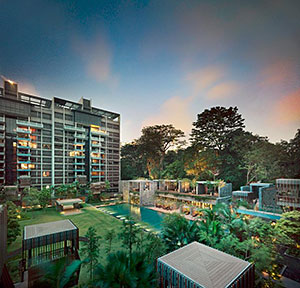Bag (a sort of) property bargain in Singapore

Simply sign up to the Life & Arts myFT Digest -- delivered directly to your inbox.
It is a problem many city mayors would kill for. As soaring prices make home ownership unaffordable and housing bubbles threaten economic stability, Singapore’s house prices have been experiencing a steady run of deflation.
Core central prices dropped 4 per cent in 2014. At $2,050 per square foot, according to Savills, they are 11 per cent off their 2007 peak. Alan Cheong of the firm’s Singapore office says buyers are betting on further falls; transaction levels this year have slumped and only the desperate are selling — the market lost a further 3.3 per cent in the first quarter.
The price drops reflect overly successful efforts by the government to cool the market following steep inflation after the financial crisis. Several were targeted at foreign buyers, who in December 2011 were hit with a 10 per cent surcharge to the local 3 per cent stamp duty; a year later this was raised to 15 per cent.
But the real brake on foreign and domestic buyers has been tighter lending, says Nicholas Holt, head of Asia-Pacific research at Knight Frank. In June 2013 the government limited total mortgage repayment commitments to 60 per cent of income and increased the checks banks had to make on borrowers. Within weeks mortgage approvals and transaction levels dropped by half.
The prime central region has suffered disproportionately. It includes Singapore’s three most sought-after neighbourhoods, Districts 9, 10 and 11, situated inland to the northwest of the financial centre. Downtown, where prime prices have also been squeezed, Christie’s has a four-bedroom apartment available in the Marina Bay Residences for S$15,888,888 ($11.8m) — the “8s” intended to lure Chinese buyers for whom the number is lucky.
The fall-off has cemented a gap between Singapore and Hong Kong that emerged in the financial crisis. At the start of the Sars crisis in 2002 Singapore homes commanded a 19 per cent premium to their Hong Kong equivalents; today they’re 33 per cent cheaper. “The key difference driving prices is supply,” says Holt, who says Singapore lacks Hong Kong’s powerful developers, who lobby the government to hold back usable land to keep prices high.

At the top of the market the gap is now huge. The record price per square foot in Singapore, $3,620, set last year for a 2,755 sq ft unit at Reignwood Hamilton Scotts, pales in comparison to top prices in mid-level Hong Kong, where the April top, Asia’s record, was achieved at 39 Conduit Road — $11,990 per sq ft.
With prices cheap, agents are talking up the greater space and range of outdoor life in Singapore, as well as its safety, which make it especially appealing to families. Crime levels are very low — only Tokyo scored above it in the latest Safe Cities Index from the Economist Intelligence Unit. While the island state is larger than Hong Kong island, restrictions on foreign ownership of houses mean that condominiums, which tend to have better communal facilities, are the favoured choice for families.
Savills has various four-bedroom apartments for sale in the Leedon Residence condominium in District 10, situated in gardens, from S$4.5m to S$5.7m. Knight Frank has a ground floor three-bedroom apartment in the Goodwood Residence in District 10, which also includes a pool and large patio, for S$5m.

Rental bargains can be found too — most western expatriates rent because postings are typically four years long, says Holt. Low rents helped Singapore’s economy into its seventh straight month of deflation in May. “There’s a lot of wiggle room on price,” says Holt. A recent restriction by the government on foreign worker quotas is also helping existing tenants by reducing demand.
Schools are excellent: Singaporeans are effectively prevented from sending their children to expat schools; the competition for places at these schools is less intense than in Hong Kong, says Holt. Public transport is cheap and efficient — the maximum standard fare is S$2.30. Some of the world’s finest beaches are a short flight away: Phuket in Thailand can be reached in less than two hours; the flight to Bali is two hours 40 minutes.
But living costs are high relative to Hong Kong, which only raises sales tax on alcohol and tobacco; beer in Singapore costs more than double that in Hong Kong. Expats say things such as extra school classes and sports clubs are pricier too. And the government has made car ownership eye-wateringly expensive. A two-litre Volvo, for example, will cost S$161,000 in taxes alone.
If you can survive without a car the savings versus Hong Kong look good. Cheong says buyers at the lower and mid levels have been returning this year. “High net worth buyers like to follow the cult, so this will spill over to rich domestic buyers, then to those overseas,” he says. There is something of the boundless optimism of the sales agent in this logic. But the Singapore government will be hoping he is right.
Buying guide
● Singapore organises its districts by number. The best housing is found in the core central region, which comprises six districts: 1, 2 and 4, as well as the most sought-after, 9, 10 and 11.
● Stamp duty for locals is 3 per cent. Foreign buyers, except those from the US and Switzerland and those classed as permanent residents, must pay an additional 15 per cent.
● About 20 per cent of stock is available to foreign buyers. This includes a small number of houses, most of which are situated on Sentosa Island.
What you can buy for . . .
$1m A 600 sq ft one-bedroom apartment in a condominium block near the seafront or in District 9 or 10.
$5m A three-bedroom 2,500 sq ft apartment in one of Singapore’s premium condominiums in District 9 or 10.
$15m A four-bedroom house with a garden on Sentosa
Photograph: Getty Images/Flickr RF
Comments